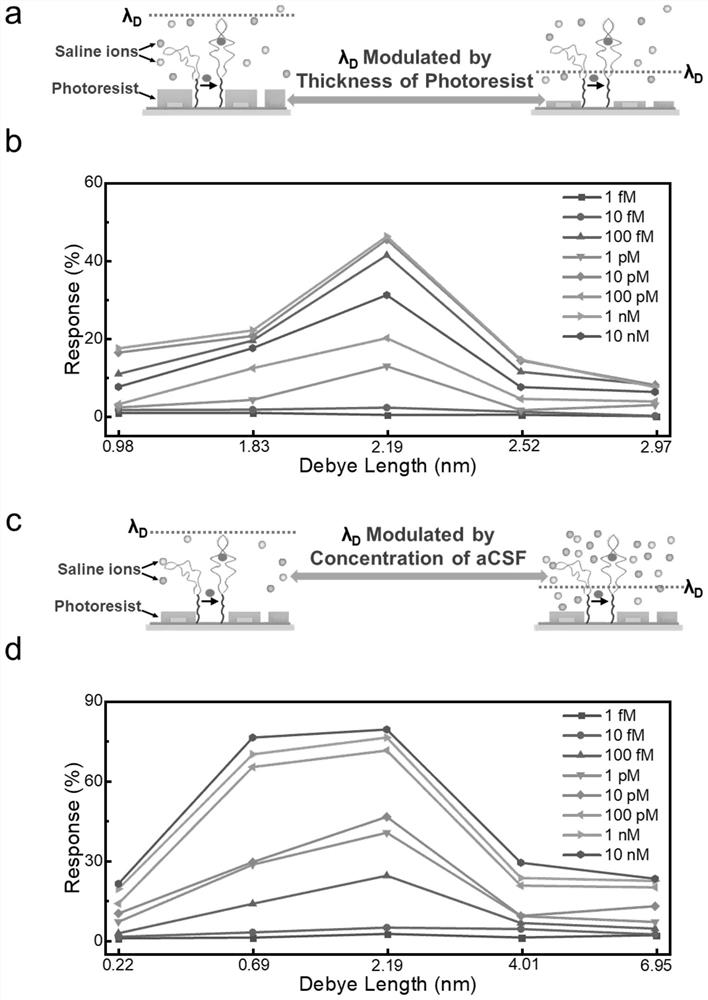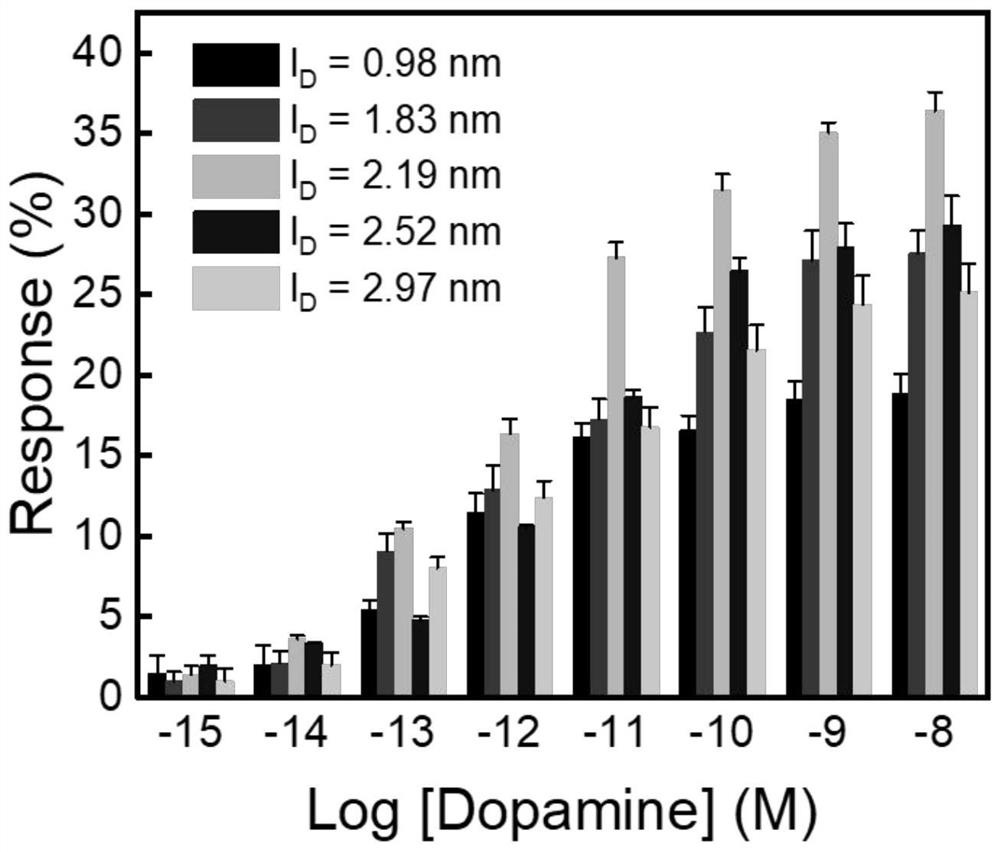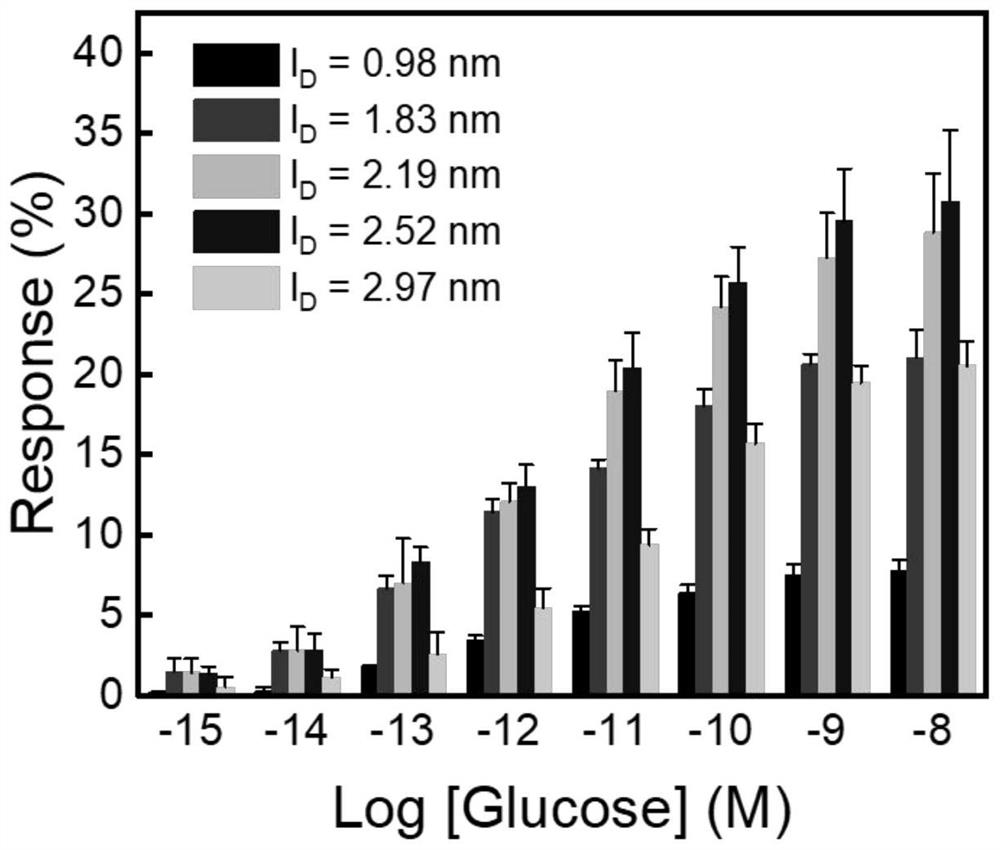Method for adjusting sensitivity of FET (Field Effect Transistor) biosensor
A biosensor, sensitivity technology, applied in the field of biosensors, can solve problems such as reducing the performance of FET biosensors
- Summary
- Abstract
- Description
- Claims
- Application Information
AI Technical Summary
Problems solved by technology
Method used
Image
Examples
Embodiment 1
[0030] The purpose of this example is to study the effect of different passivation layer thicknesses and ionic strengths on the sensitivity of FET biosensors based on serotonin nucleic acid aptamers. The specific methods are as follows:
[0031] S1, calculate the range value of the passivation layer thickness of the biosensor to be prepared according to the existing data records and the dielectric constant formula of the passivation layer, and the specific calculation process is as follows:
[0032] According to the information, the electrostatic force constant K is 8.98×10 9 Nm 2 / C 2 , the vacuum permittivity ε 0 8.85×10 -12 F / m, Boltzmann constant K B is 1.38×10 -23 J / K, temperature (Kelvin) T is 293.16K, Avogadro's number Na is 6.02×10 23 , the basic charge e is 1.60 × 10 -19 C;
[0033] The test results: the capacitance C / S per unit area of the passivation layer is 58.3pF / mm 2 ;
[0034] Substitute the above data into the dielectric constant In the formula, ...
Embodiment 2
[0046] The purpose of this example is to study the effect of different passivation layer thicknesses and ionic strengths on the sensitivity of FET biosensors based on dopamine aptamers. The specific methods are as follows:
[0047] According to the information, the electrostatic force constant K is 8.98×10 9 Nm 2 / C 2 ;
[0048] The test results: the capacitance C / S per unit area is 58.3pF / mm 2 ,
[0049] Substitute the above data into the dielectric constant formula Among them, the thickness range of the obtained passivation layer is between 1.0 and 9.3 μm.
[0050] S2, calculate the ionic strength range value of the target to be tested according to the existing data records and the Debye length formula. The specific calculation process is as follows:
[0051] Check the information to get: vacuum dielectric constant ε 0 8.85×10 -12 F / m, Boltzmann constant K B is 1.38×10 - 23 J / K, temperature (Kelvin) T is 293.16K, Avogadro's number Na is 6.02×10 23 , the basic ch...
Embodiment 3
[0058] The purpose of this example is to study the effect of different passivation layer thicknesses and ionic strengths on the sensitivity of FET biosensors based on glucose nucleic acid aptamers. The specific methods are as follows:
[0059] S1, calculate the range value of the passivation layer thickness of the biosensor to be prepared according to the existing data records and the dielectric constant formula of the passivation layer, and the specific calculation process is as follows:
[0060] According to the information, the electrostatic force constant K is 8.98×10 9 Nm 2 / C 2 ;
[0061] The test results: the capacitance C / S per unit area is 58.3pF / mm 2 ,
[0062] Substitute the above data into the dielectric constant formula Among them, the thickness range of the obtained passivation layer is between 1.0 and 9.3 μm.
[0063] S2, calculate the ionic strength range value of the target to be tested according to the existing data records and the Debye length formula...
PUM
| Property | Measurement | Unit |
|---|---|---|
| Thickness | aaaaa | aaaaa |
| Ionic strength | aaaaa | aaaaa |
Abstract
Description
Claims
Application Information
 Login to View More
Login to View More - R&D
- Intellectual Property
- Life Sciences
- Materials
- Tech Scout
- Unparalleled Data Quality
- Higher Quality Content
- 60% Fewer Hallucinations
Browse by: Latest US Patents, China's latest patents, Technical Efficacy Thesaurus, Application Domain, Technology Topic, Popular Technical Reports.
© 2025 PatSnap. All rights reserved.Legal|Privacy policy|Modern Slavery Act Transparency Statement|Sitemap|About US| Contact US: help@patsnap.com



